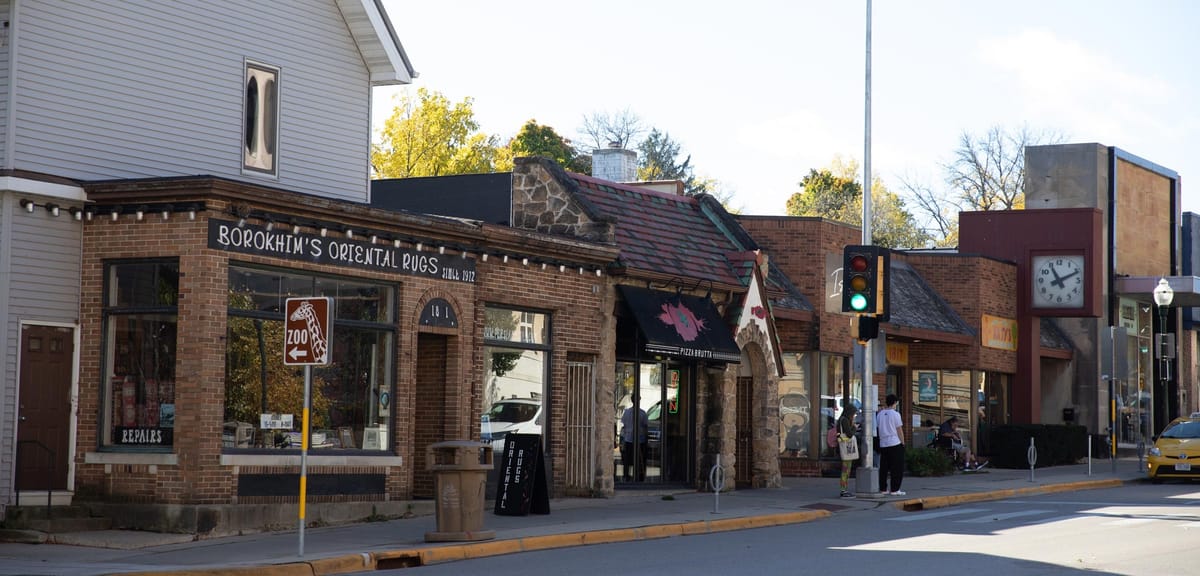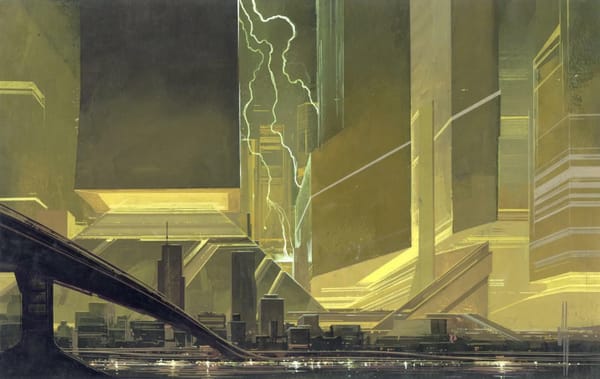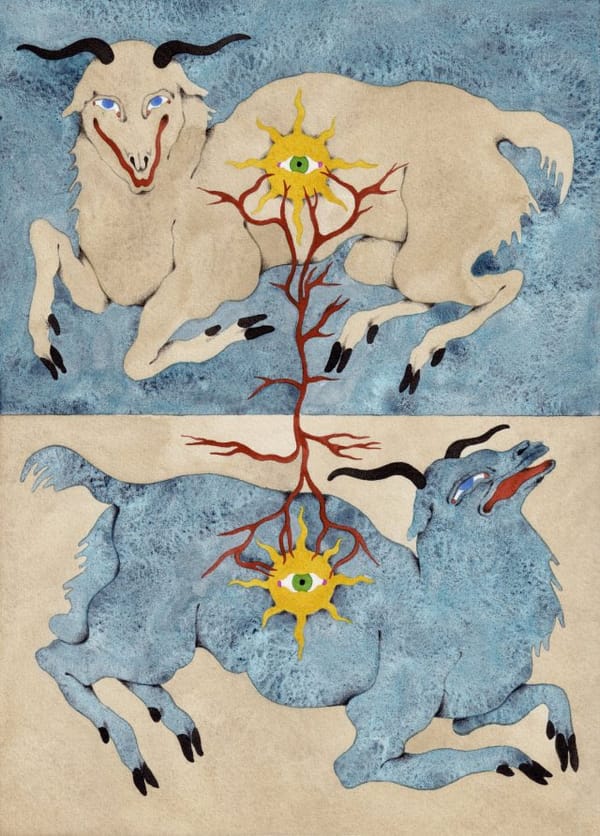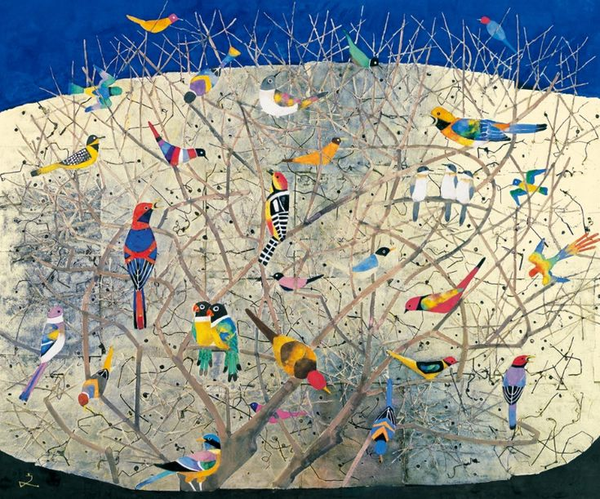Odana Monroe Regent Washington

I. Odana
The West Towne Mall sprawls out like Disneyworld at Odana's western terminus. They brought in a helicopter to install its 30 rooftop AC units in the 60s. This is where you stock up on base spirits at Total Wine & More, or where you smother your better judgment with a pillow in the Chick-Fil-A drive-thru.
The mall hugs the north-south thoroughfare of Gammon Road. Odana t-bones it from the east. To turn left off Gammon going into the mall or onto Odana, you briefly play chicken with the left-turners across from you, owing to the intersection's odd design.
Starting down this road, you push steadily eastward, slithering south a few times, down a dazzling (in its way) corridor of economic activity. Crazy Lenny’s Electric Bikes, Jo-Ann’s Fabrics, thrift stores, empty lots primed for construction. There's the car repair place where you wait for the tech's ancient system to return a quote as he tells you about the ferry up in the Dells that takes your car across the river for free. There are brown shingled buildings that remind you of how long it’s been since you saw a dentist. There's a field of dealerships with red-lit cell towers sticking up behind them that make you feel like you’re on a lunar base. Two-laned yet heavily trafficked, this stretch demands extra boldness from those who wish to merge onto it.
It goes on for half of Odana's length, bookended by a more utilitarian shopping center, and then, turning a few degrees northward, it becomes residential for its second half. Sloping hills, speed limits no one follows, wild turkeys roaming the golf course. A well-maintained bike trail crosses it right before Monroe. You can’t see down it in either direction until you’re on top of it, and its users (not me, I’m built different) are often oblivious so you briefly have to obey the speed limit and then some. In early winter, the big inflatable yard Santas start to crop up here, getting denser as you drive, though in some yards you'll instead see rebelliously reclining Rudolphs. At a woodsy three-way intersection a dedicated merge lane invites you sweetly onto Monroe.
II. Monroe
It starts like Odana. An old lawnmower has sat on a curb here for years.
The clues that something's different add up. The dog coats are glossier. The houses are more craftsman. The Arboretum sidles up against the road like a red carpet for Lake Wingra. The Santas in winter are more militant and regimented, waving at you from yards and the tops of apartment buildings like Saddam Hussein statues. Steely gazes from those who roam the incense-scented trinket shops – or the Trader Joe's, even – size up your unaligned chakras. You're in crystal country now, boy. Here the city begins to punch above its weight class in food and drink: Lallande, Pizza Brutta, Bloom Bake Shop, Garth’s. The pine smells in winter have always reminded me of Tahoe; Monroe's commercial stretches, with their brickwork and fancy coffee and murals fit for the 'gram, complete the illusion.
The wholesomeness here is realer, though; more stuck-in-time, relaxed, not hoighty-toighty, not creepy in a Stepford Wives way. You'll bike to the boat launch area at Wingra Park on June weekends and let the dog run around. You'll once again see Odana-style Americana as you near Camp Randall Stadium, the Civil War command center turned sports arena. You could continue for a few blocks if you wanted, but in all likelihood your business will instead involve a slight turn onto Regent, where you may wait for a horde of pedestrians in cherry red to cross.
III. Regent
The sudden jutting-up of student housing buildings is one hint that you’re nearing the downtown. More than that, there’s a mosaic-like mix of vibes: a fancy bookstore bar near a McDonald’s, a Qdoba by a university hospital, sports pubs that stop short of being too divey for college nerds, restaurants that achieve culinary hipness with crowd-pleasing soul food.
It’s a short street. It ends quickly after a burst of critical infrastructure: train tracks, hotels, Panera bread.
Odana is the guy you’d grab a beer with; this length of Regent, though less friendly, is humbler and less pretentious. It represents the crunchy middle layer of a city – places where you cram FedEx stores and massive intersections because they have to go somewhere. Across America this sort of area ties our suburban-plus-urban regions (such regions being where like 80% of us live) together. Regent is a certain kind of lifeblood, a crusty old fridge in the garage from 1983 that still runs.
IV. Washington
The state capitol takes over the view once you turn onto West Wash, rising over the trees and peering through the rented frat houses and CVSes. On weekend evenings in fall or spring, the students may be hollering, and on weekend mornings in summer the farmer's market in the square may be buzzing. One time when the square was mostly empty I saw a guy walking around it and screaming obscenities in the capitol's general direction.
A star of roads protrudes from the square. Any one you walk down takes you somewhere; west down State Street takes you to UW and the student union on the lake; northwest to the Edgewater and the best pub trivia surroundings on the planet; southeast to the Frank Lloyd Wright-designed Monona Terrace. The buildings on the square hold offices, apartments, museums, libraries, churches, fine cheese, coffee, everything you'd normally find; they're also cropped by law to be no higher than the capitol for a mile around, preserving both a nice view and skyrocketing rents. With a lake on either side of you, you start to sense that Madison, if it were a human, would be one of those maddening people who have a world-class talent, yet are also physically beautiful, yet are also kind and humble about it. They merit smugness, but don’t even have it, and so to their haters can only really say: you mad? (San Francisco and Seattle, though possessing more big-city pitfalls than Madison, have similar things going on.)
On the other side of the capitol, East Wash continues, taking you through a smorgasbord of decadently easy street parking, swathes of top-tier bars and food, and old centers of heavy industry that are now flecked with distilleries and concert venues – a millennial's Shangri-La. It goes straight as an arrow over to the artsy east side. There’s more here, like the dual wonders of Mint Mark and Tex Tubb’s Taco Palace, but I find the road’s remaining journey less compelling than it is on the west side.
It fades out and away, a flat smooth gradient along the spectrum of urban-to-suburban. It almost imperceptibly turns back into parks, yoga studios, supper clubs, community colleges. Not long after the East Towne Mall it ceases to be East Wash altogether; it actually became synonymous with Highway 151 a few blocks after the capitol. This can take you all the way to Green Bay, if you so choose, though so far I haven't.





